Effect of FeO Content on Foaming and Viscosity Properties in FeO-CaO-SiO2-MgO-Al2O3 Slag System
Abstract
1. Introduction
2. Materials and Methods
2.1. Slag Sampling and Characterization
2.2. Foaming Experiment
3. Results and Discussion
3.1. Thermo-Calc Phase Diagram Simulation
3.2. Viscosity Analysis and High-Temperature Optical Image Observation
3.3. Viscosity Analysis and High-Temperature Optical Image Observation
4. Conclusions
- The viscosity of the slag sample increased as FeO content decreases. At a slag composition of 9.9% FeO, 53% CaO, 24.2% SiO2, 6.2% Al2O3, and 6.7% MgO, the maximum viscosity was recorded at 1550 °C. When FeO content was >29.6%, the viscosity rapidly dropped to <100 cP.
- The results from the foaming experiment revealed that for the FeO-CaO-SiO2-MgO-Al2O3 slag system in the viscosity range of 25–1810 cP, the foam height ratio and viscosity exhibited a linear relationship which can be expressed as:
- Viscosity increased with increasing solid phase fraction in the slag. The experimental results revealed that the slag-containing solid fraction exhibited better foaming ability. In the six slag samples studied, the slag sample B1 (20%FeO-49.5% CaO-19.3% SiO2–5% Al2O3–5.7% MgO) exhibited the best foaming ability, and the foam height ratio was 109.7%.
Author Contributions
Funding
Institutional Review Board Statement
Informed Consent Statement
Data Availability Statement
Acknowledgments
Conflicts of Interest
References
- Kwong, K.S.; Bennett, J.P. Recycling practices of spent MgO-C refractories. J. Miner. Mater. Charact. Eng. 2002, 1, 69–78. [Google Scholar] [CrossRef]
- Kozhukhov, A.A.; Fedina, V.V. Study of the foaming of steelmaking slag and its effect on the thermal performance of an electric-arc furnace. Metallurgist 2012, 56, 169–172. [Google Scholar] [CrossRef]
- Kipepe, T.M.; Pan, X. Energy improvement in induction furnace using foaming slag with variation of carbon injection. J. Energy South. Afr. 2015, 26, 64–73. [Google Scholar] [CrossRef]
- Morales, R.D.; Rubén, L.G.; López, F.; Camacho, J.; Romero, J.A. The slag foaming practice in EAF and its influence on the steelmaking shop productivity. ISIJ Int. 1995, 35, 1054–1062. [Google Scholar] [CrossRef]
- Ito, K.; Fruehan, R.J. Study on the foaming of CaO-SiO2-FeO slags: Part I. Foaming parameters and experimental results. Metall. Trans. B 1989, 20, 509–514. [Google Scholar] [CrossRef]
- Ito, K.; Fruehan, R.J. Study on the foaming of CaO-SiO2-FeO slags: Part II. Dimensional analysis and foaming in iron and steelmaking processes. Metall. Trans. B 1989, 20, 515–521. [Google Scholar] [CrossRef]
- Stadler, S.A.; Eksteen, J.J.; Aldrich, C. Physical modelling of slag foaming in two-phase and three-phase systems in the churn-flow regime. Miner. Eng. 2006, 19, 237–245. [Google Scholar] [CrossRef]
- Pilon, L.; Fedorov, A.G.; Viskanta, R. Steady-state thickness of liquid–gas foams. J. Colloid Interface Sci. 2001, 242, 425–436. [Google Scholar] [CrossRef]
- Jiang, R.; Fruehan, R.J. Slag foaming in bath smelting. Metall. Trans. B 1991, 22, 481–489. [Google Scholar] [CrossRef]
- Luz, A.P.; Tomba Martinez, A.G.; López, F.; Bonadia, P.; Pandolfelli, V.C. Slag foaming practice in the steelmaking process. Ceram. Int. 2018, 44, 8727–8741. [Google Scholar] [CrossRef]
- Bhoi, B.; Jouhari, A.K.; Ray, H.S.; Misra, V.N. Smelting reduction reactions by solid carbon using induction furnace: Foaming behaviour and kinetics of feo reduction in CaO–SiO2–FeO slag. Ironmak. Steelmak. 2006, 33, 245–252. [Google Scholar] [CrossRef]
- Kim, H.S.; Min, D.J.; Park, J.H. Foaming behavior of CaO–SiO2–FeO–MgOsatd–x (x = Al2O3, MnO, P2O5, and CaF2) slags at high temperatures. ISIJ Int. 2001, 41, 317–324. [Google Scholar] [CrossRef]
- Lee, S.; Min, D.J. Viscous behavior of FeO-bearing slag melts considering structure of slag. Steel Res. Int. 2018, 89, 1800055. [Google Scholar] [CrossRef]
- Martinsson, J.; Glaser, B.; Sichen, D. Study on apparent viscosity of foaming slag—cold model and high temperature experiments. In Advances in Molten Slags, Fluxes, and Salts: Proceedings of the 10th International Conference on Molten Slags, Fluxes and Salts 2016; Springer: Berlin/Heidelberg, Germany, 2016. [Google Scholar]
- Pretorius, E.B.; Carlisle, R.C. Foamy slag fundamentals and their practical application to electric furnace steelmaking. In Proceedings of the 56th Electric Furnace Conference, New Orleans, LA, USA, 15–18 November 1998. [Google Scholar]
- Luz, A.P.; Ávila, T.A.; Bonadia, P.; Pandolfelli, V.C. Slag foaming: Fundamentals, experimental evaluation and application in the steelmaking industry. Refract. Worldforum 2011, 3, 91–98. [Google Scholar]
- Seok, S.H.; Jung, S.M.; Lee, Y.S.; Min, D.J. Viscosity of highly basic slags. ISIJ Int. 2007, 47, 1090–1096. [Google Scholar] [CrossRef]
- Lee, Y.S.; Min, D.J.; Jung, S.M.; Yi, S.H. Influence of basicity and FeO content on viscosity of blast furnace type slags containing FeO. ISIJ Int. 2004, 44, 1283–1290. [Google Scholar] [CrossRef]
- Pilon, L.; Viskanta, R. Minimum superficial gas velocity for onset of foaming. Chem. Eng. Process. Process Intensif. 2004, 43, 149–160. [Google Scholar] [CrossRef]
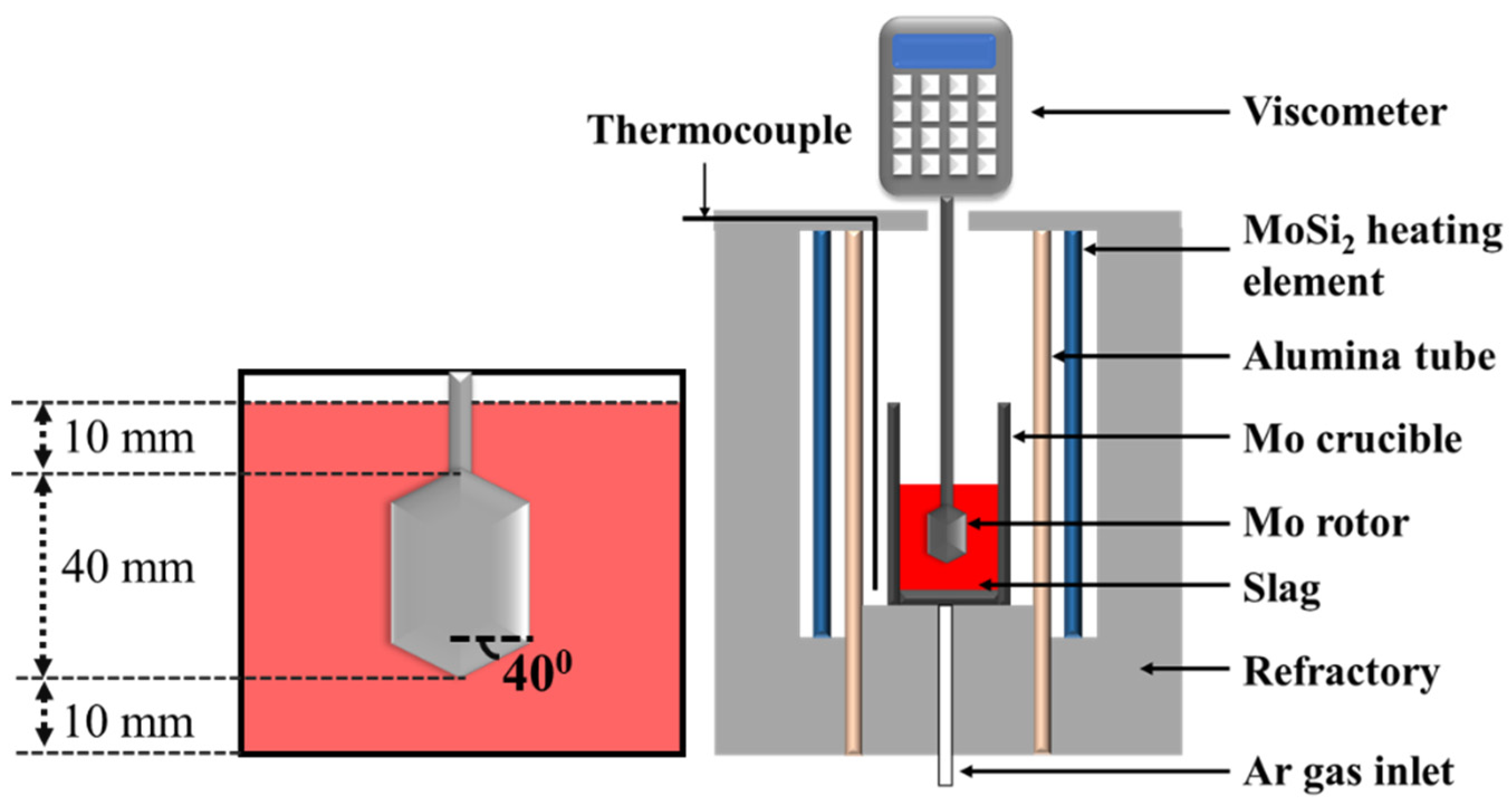
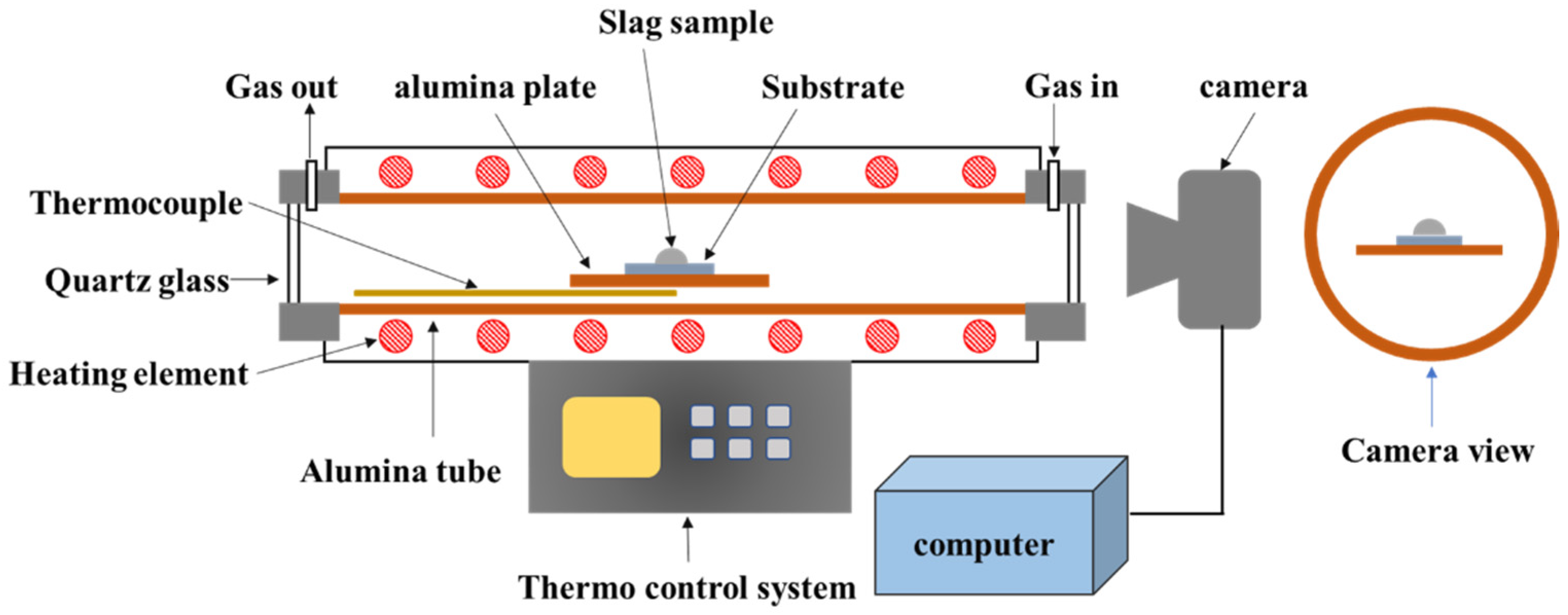
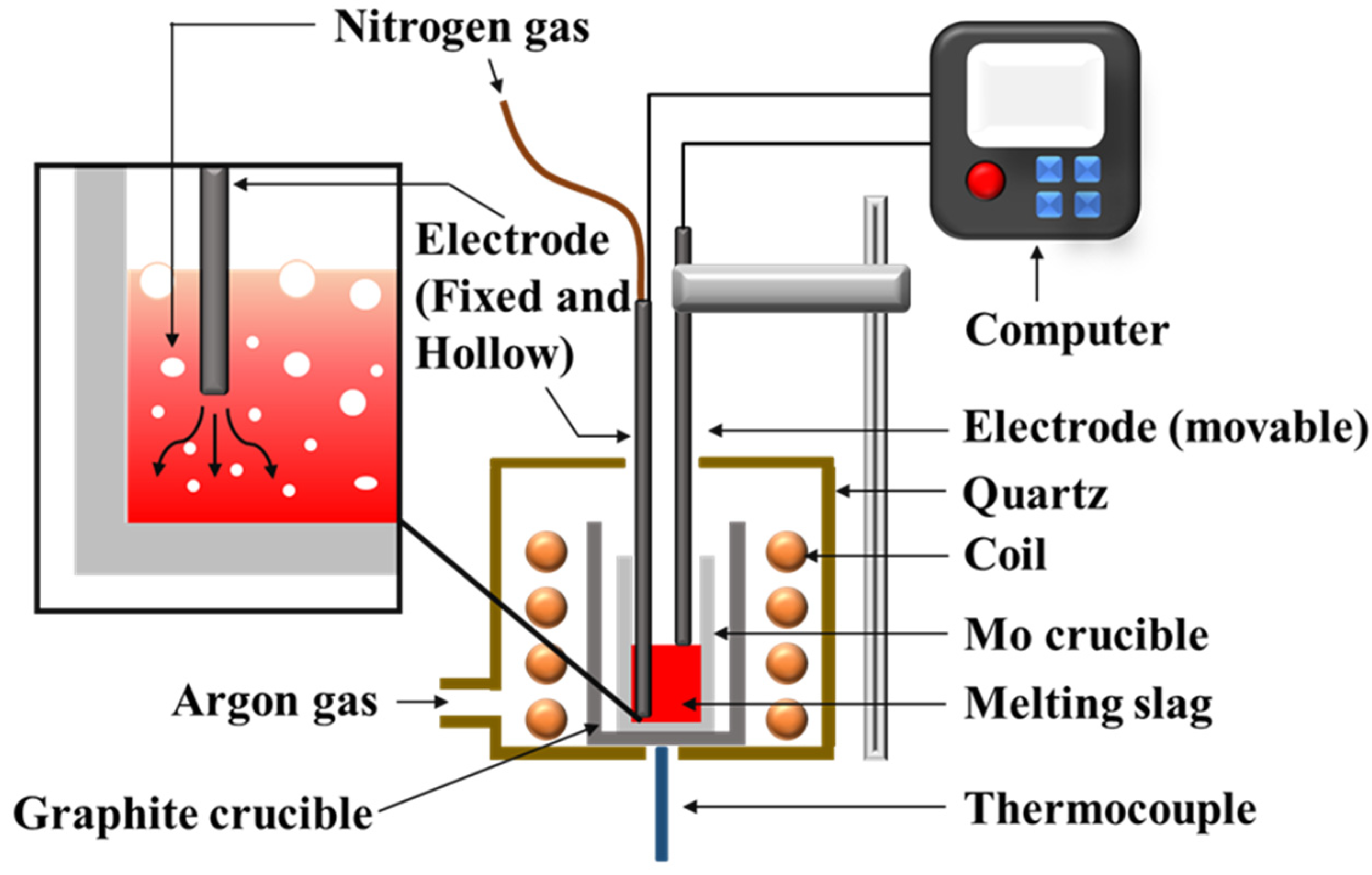

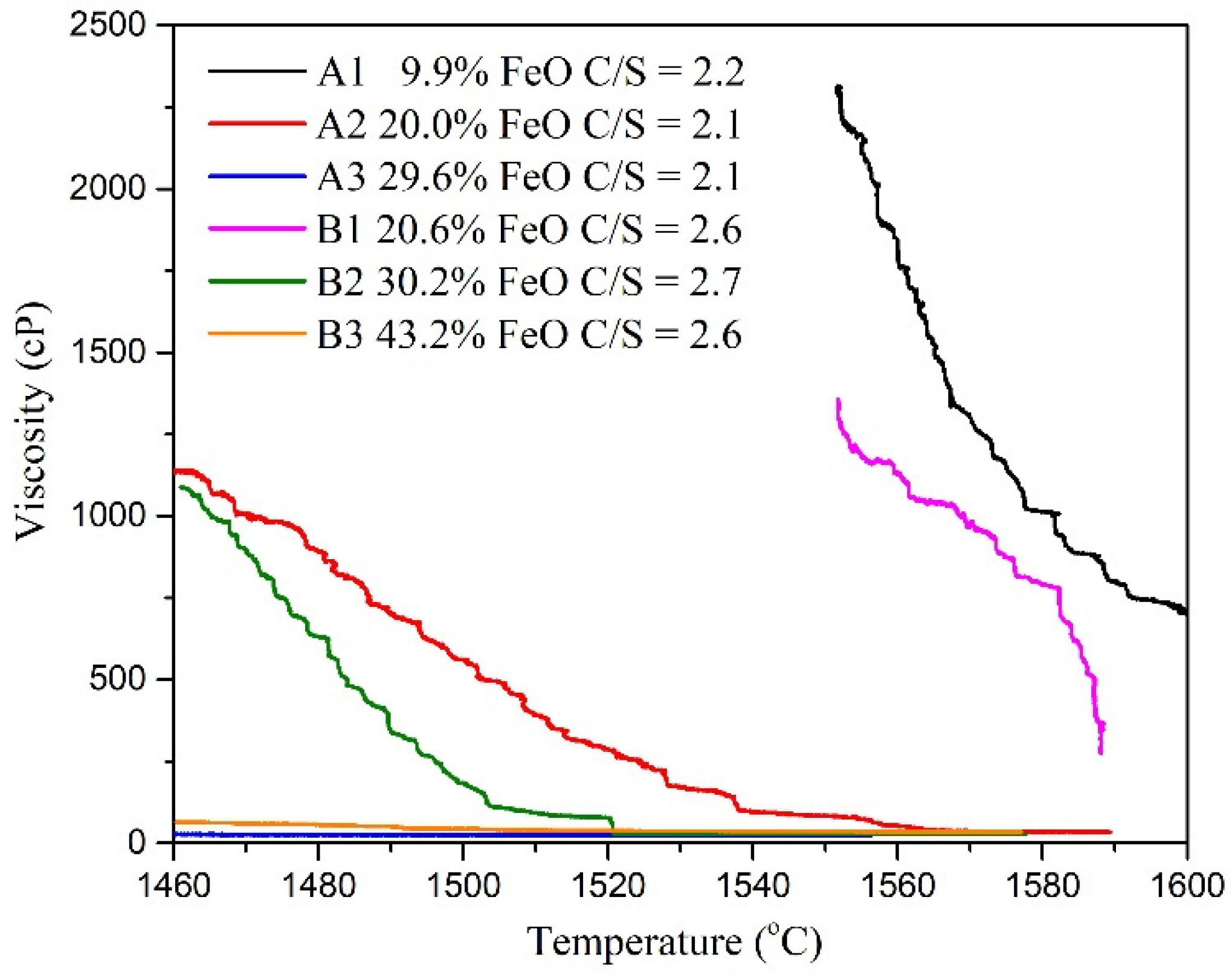
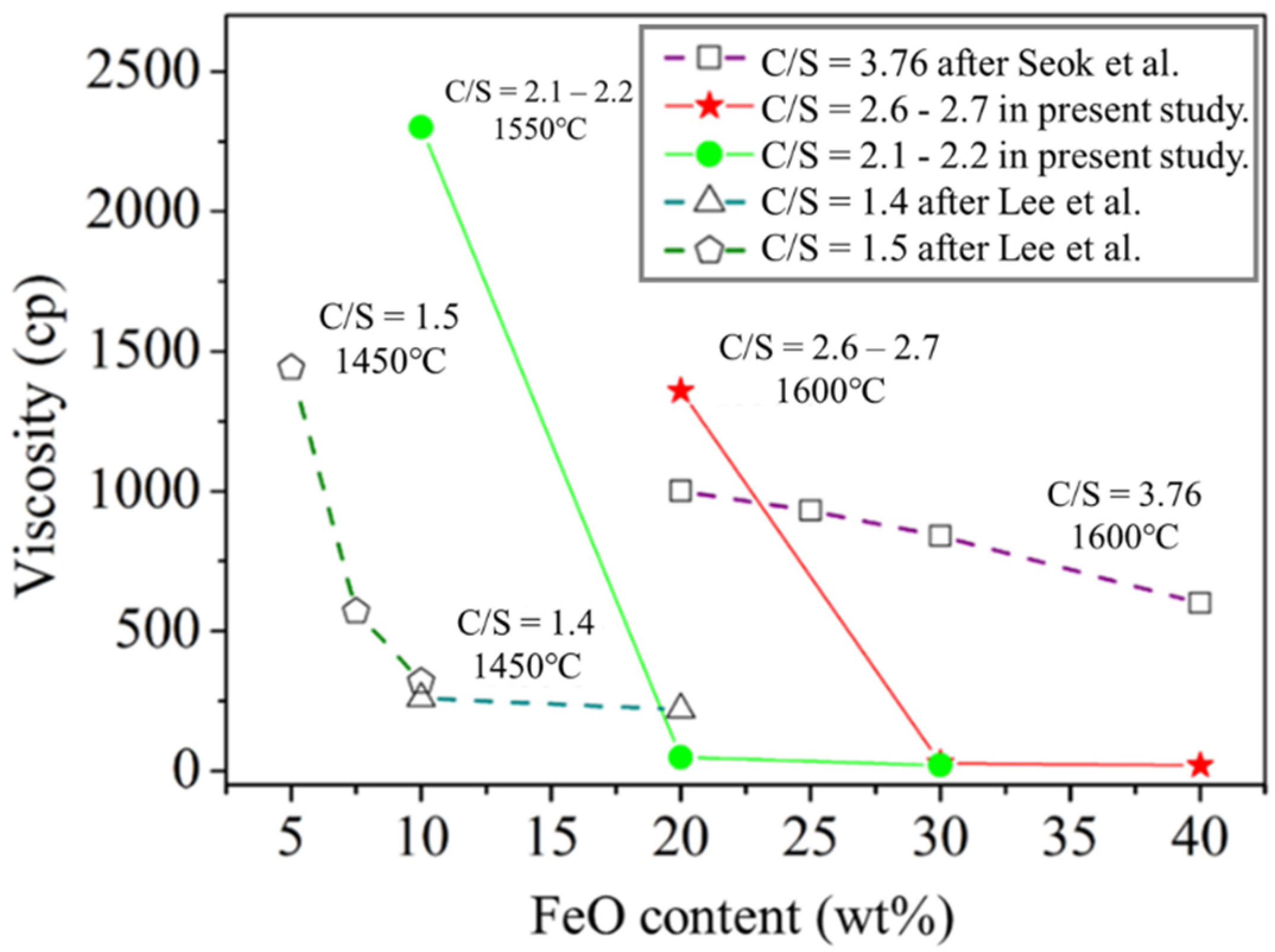
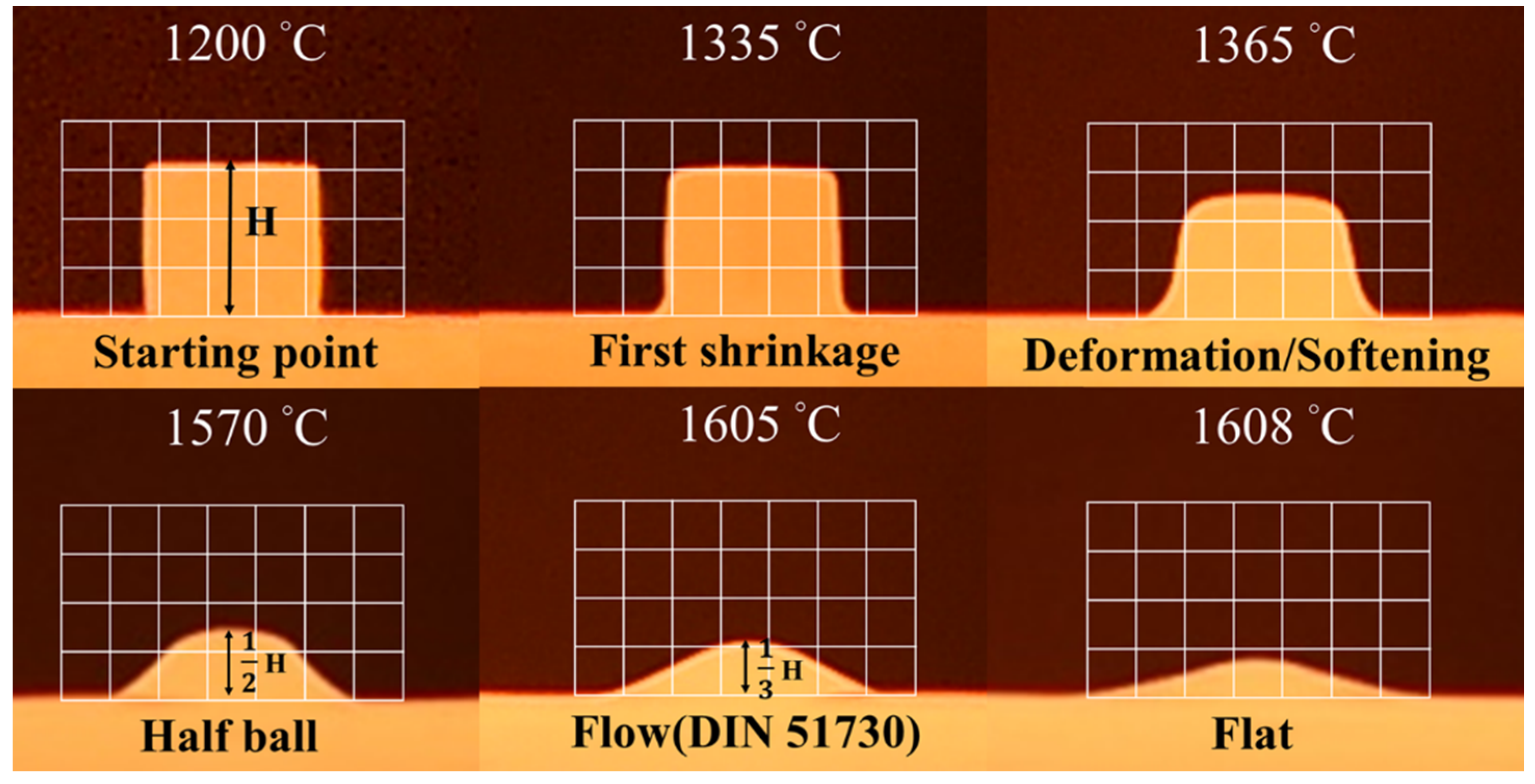
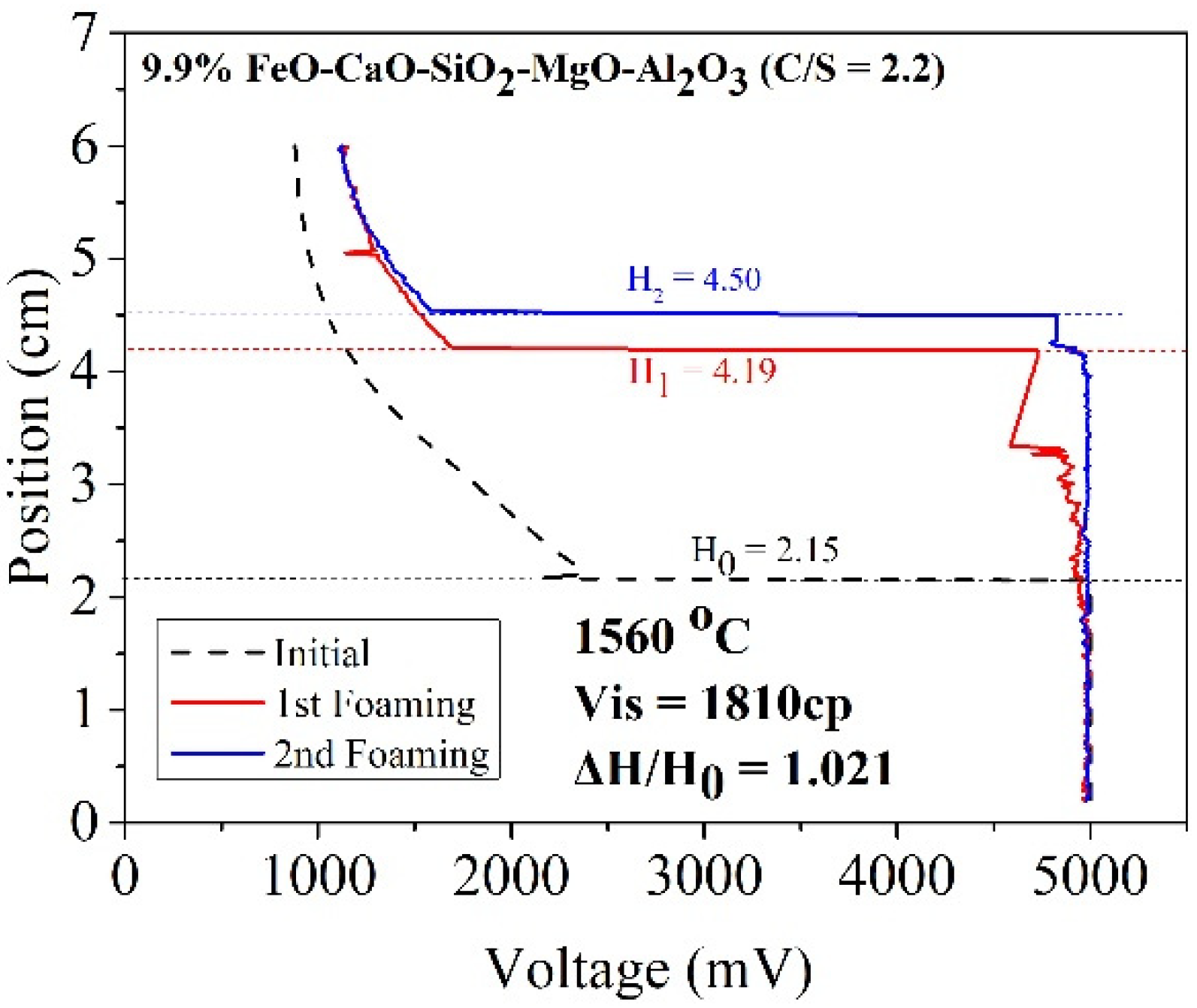
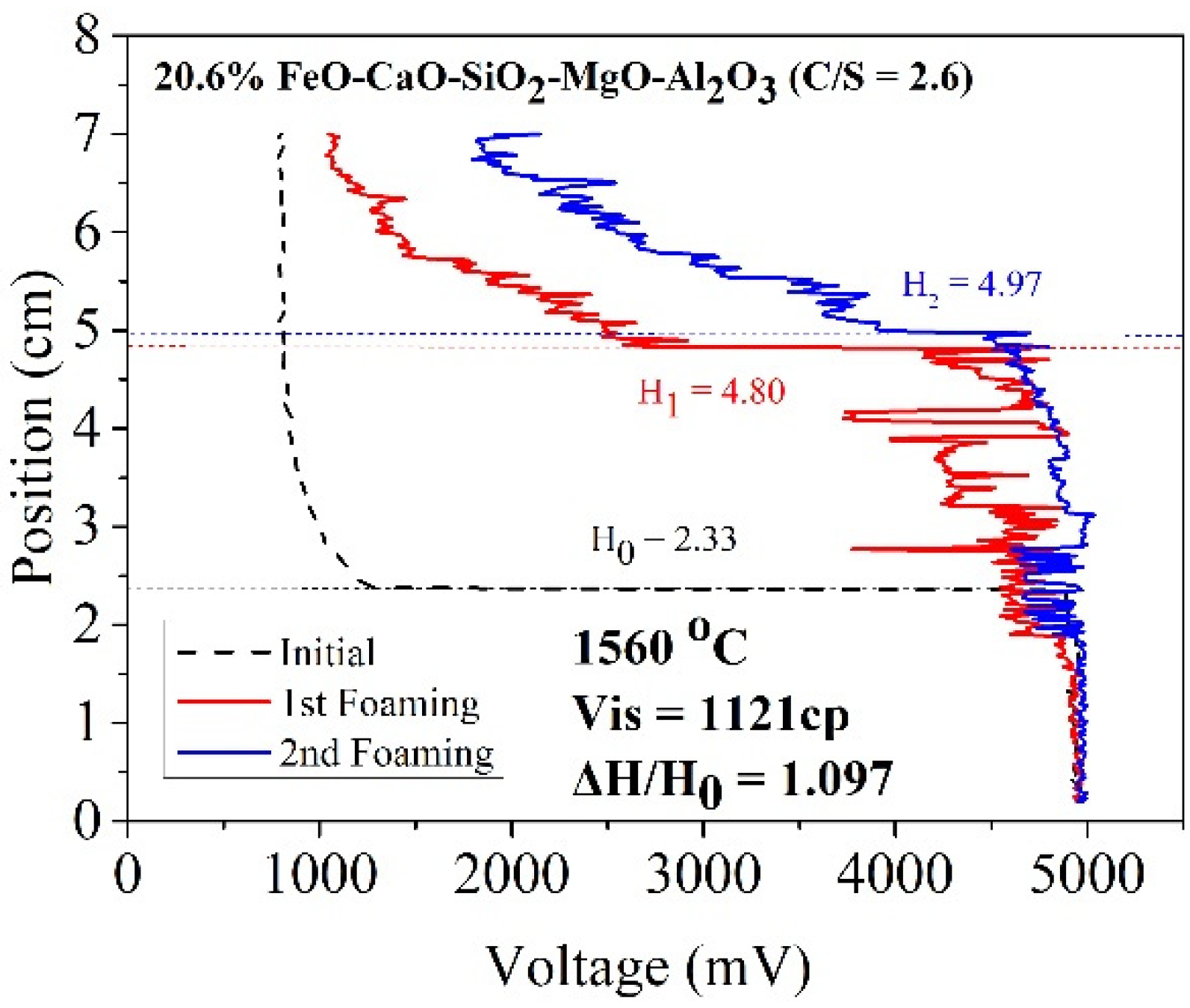
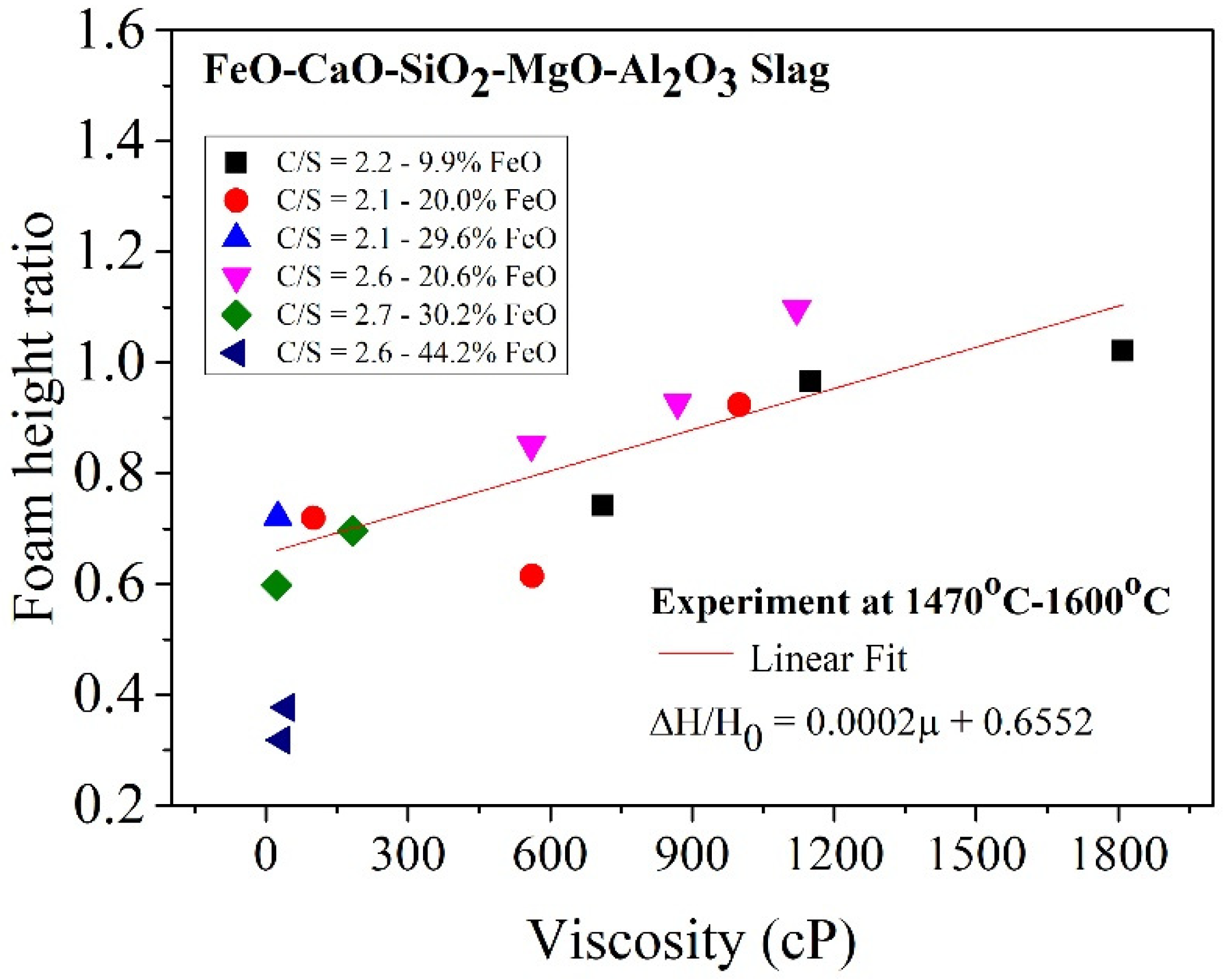
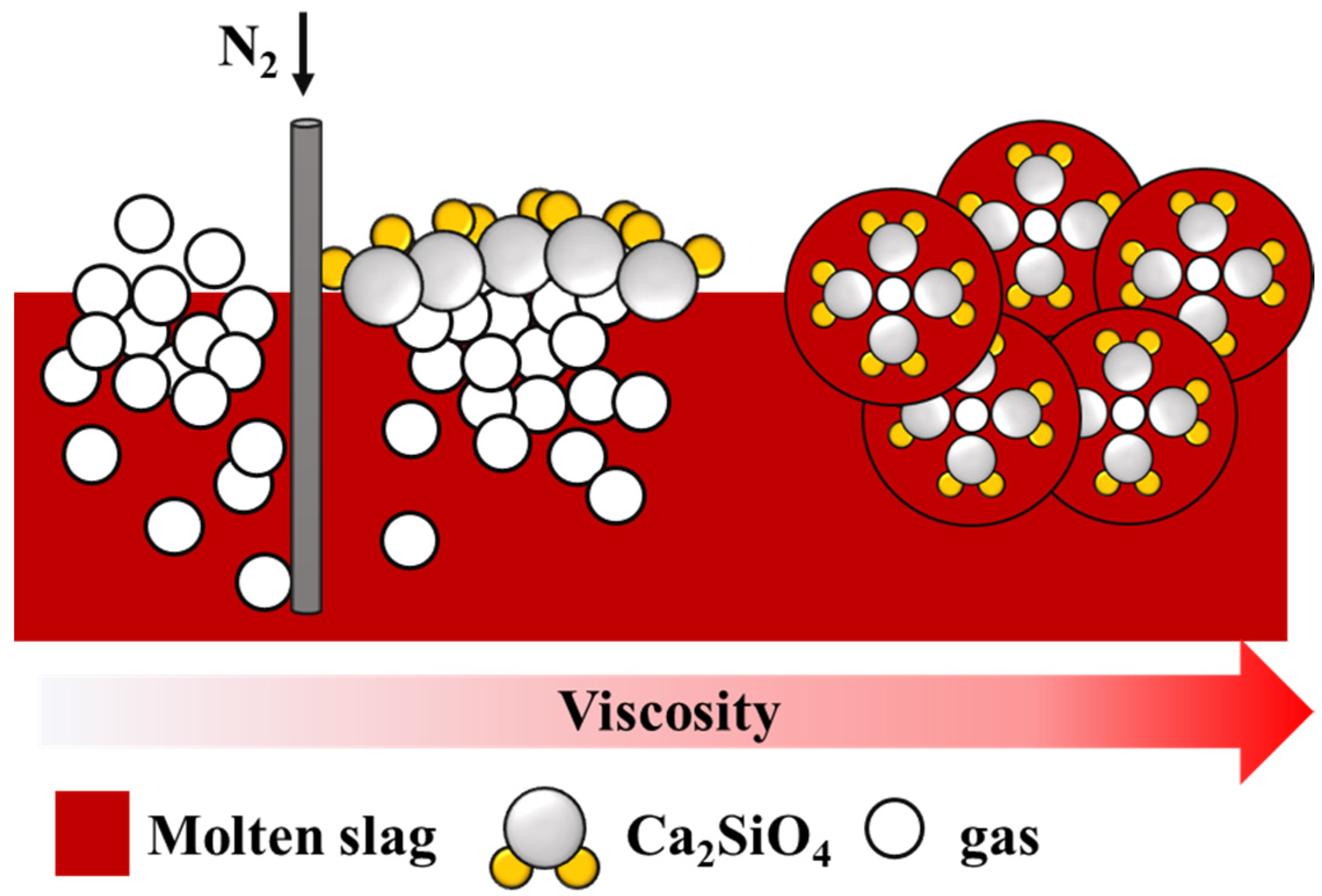
| Sample | Chemical Composition (wt.%) | |||||
|---|---|---|---|---|---|---|
| CaO | SiO2 | FeO | Al2O3 | MgO | CaO/SiO2 | |
| A1 | 53.0 | 24.2 | 9.9 | 6.2 | 6.7 | 2.2 |
| A2 | 45.0 | 21.3 | 20.0 | 6.6 | 7.1 | 2.1 |
| A3 | 39.7 | 18.7 | 29.6 | 5.3 | 6.7 | 2.1 |
| B1 | 49.5 | 19.3 | 20.6 | 5.0 | 5.7 | 2.6 |
| B2 | 42.0 | 15.6 | 30.2 | 7.2 | 5.1 | 2.7 |
| B3 | 32.6 | 12.4 | 43.2 | 7.1 | 4.7 | 2.6 |
| Sample | Solid Fraction (%) | Melting Point (°C) | ||||||
|---|---|---|---|---|---|---|---|---|
| 1350 °C | 1400 °C | 1450 °C | 1500 °C | 1550 °C | 1600 °C | 1650 °C | ||
| A1 | - | - | - | 28.8 | 21.6 | 12.7 | 1704 | |
| A2 | - | 25.6 | 21.6 | 14.2 | 5.1 | - | - | 1575 |
| A3 | 19.7 | 11.9 | 3 | - | - | - | - | 1465 |
| B1 | - | - | - | - | 22.6 | 11.1 | - | 1601 |
| B2 | - | 25.7 | 16.6 | 6.5 | - | - | - | 1503 |
| B3 | 16.4 | 6.5 | 0.2 | - | - | - | - | 1489 |
| Sample | Viscosity (cP) | |||||
|---|---|---|---|---|---|---|
| 1400 °C | 1450 °C | 1475 °C | 1500 °C | 1550 °C | 1575 °C | |
| A1 | - | - | - | - | 1700 | 1150 |
| A2 | - | 1139 | 975 | 562 | 82 | 36 |
| A3 | 28 | 28 | 27 | 25 | 22 | - |
| B1 | - | - | - | - | 1358 | 870 |
| B2 | - | 1134 | 746 | 183 | 28 | 26 |
| B3 | 454 | 64 | 59 | 43 | 36 | 34 |
| Sample | Melting Temperature (°C) | ||||
|---|---|---|---|---|---|
| Half Ball Temp. | Flow Temp. | Fully Liquid | Thermo-Calc | Vis-100 cP | |
| A1 | 1555 | 1560 | >1595 | 1704 | >1600 |
| A2 | 1420 | 1465 | 1535 | 1575 | 1538 |
| A3 | 1355 | 1370 | 1405 | 1465 | <1370 |
| B1 | 1570 | 1605 | >1608 | 1601 | >1600 |
| B2 | 1435 | 1475 | 1500 | 1503 | 1507 |
| B3 | 1335 | 1350 | 1420 | 1489 | 1431 |
| Sample | Foam Height Ratio (△H/H0) | |||||
|---|---|---|---|---|---|---|
| 1500 °C | 1550 °C | 1560 °C | 1575 °C | 1585 °C | 1600 °C | |
| A1 | - | - | 1.021 | 0.965 | - | 0.742 |
| A2 | 0.615 | 0.719 | - | - | - | - |
| A3 | 0.731 | - | - | - | - | - |
| B1 | - | - | 1.097 | 0.927 | 0.851 | - |
| B2 | 0.696 | 0.598 | - | - | - | - |
| B3 | 0.377 | - | 0.318 | 0.318 | - | - |
Publisher’s Note: MDPI stays neutral with regard to jurisdictional claims in published maps and institutional affiliations. |
© 2021 by the authors. Licensee MDPI, Basel, Switzerland. This article is an open access article distributed under the terms and conditions of the Creative Commons Attribution (CC BY) license (http://creativecommons.org/licenses/by/4.0/).
Share and Cite
Chang, W.-T.; Lin, C.-M.; Su, Y.-L.; Li, C.-C.; Chang, Y.-E.; Shen, J.-M.; Wu, W. Effect of FeO Content on Foaming and Viscosity Properties in FeO-CaO-SiO2-MgO-Al2O3 Slag System. Metals 2021, 11, 289. https://doi.org/10.3390/met11020289
Chang W-T, Lin C-M, Su Y-L, Li C-C, Chang Y-E, Shen J-M, Wu W. Effect of FeO Content on Foaming and Viscosity Properties in FeO-CaO-SiO2-MgO-Al2O3 Slag System. Metals. 2021; 11(2):289. https://doi.org/10.3390/met11020289
Chicago/Turabian StyleChang, Wei-Ti, Chi-Ming Lin, Yu-Lang Su, Chia-Chun Li, Yu-En Chang, Jyun-Ming Shen, and Weite Wu. 2021. "Effect of FeO Content on Foaming and Viscosity Properties in FeO-CaO-SiO2-MgO-Al2O3 Slag System" Metals 11, no. 2: 289. https://doi.org/10.3390/met11020289
APA StyleChang, W.-T., Lin, C.-M., Su, Y.-L., Li, C.-C., Chang, Y.-E., Shen, J.-M., & Wu, W. (2021). Effect of FeO Content on Foaming and Viscosity Properties in FeO-CaO-SiO2-MgO-Al2O3 Slag System. Metals, 11(2), 289. https://doi.org/10.3390/met11020289






